Its local name is “Little Devil.” But not much is known about this elusive bird, either on land or at sea. An intrepid group of conservationists go on an expedition in the mountains of the Dominican Republic to find out more about the Black-capped Petrel.
A Seabird in the Mountains
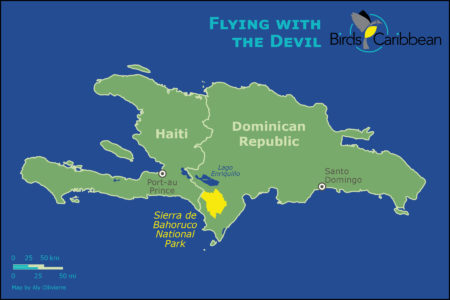
We park the pickup trucks at the park ranger’s hut and unload our gear and supplies. I climb the flimsy wooden stairs of the nearby fire tower, hoping to catch a glimpse of the sunset. We have arrived on the ridge of the Sierra de Bahoruco, the Dominican Republic’s southernmost relief and the eastern end of the De la Selle mountain range. This is the backbone of Hispaniola’s southern peninsula. Below me, the forest of Occidental pines unfurls in a deep green velvet. To the north, I can see the dark plains surrounding Lago Enriquillo, already in the shadow of the mountains. To the southwest, the glistening waters of the Caribbean Sea. Further to the west, below the setting sun, Haiti is already disappearing in the fog that has started to accumulate against the escarpment. From atop the fire tower, I try to imagine what might happen in a few hours. Not far from our camp, a small silhouette will pierce the night clouds, crashing through the trees before rushing to its burrow. It’s a Black-capped Petrel – the region’s only endemic seabird and one of the most endangered seabird species in the Atlantic Basin. The petrel is returning to feed its single chick after a week at sea.
For the next two weeks, we will stay in the mountains of the Sierra de Bahoruco National Park to try and gather more information about how this elusive bird behaves at sea. Our team consists of Ernst Rupp, senior researcher and project manager at Grupo Jaragua, the Dominican conservation NGO monitoring the petrel’s nesting sites in the country; Pirrín Jairo Matos, Gerson Feliz, José Luis Castillo and Ivan Terrero, indispensable field technicians with Grupo Jaragua; Patrick Jodice, lead scientist at USGS – South Carolina Cooperative Fish & Wildlife Research Unit (SC CRU); and myself, Yvan Satgé, early career biologist at the SC CRU – Clemson University. As the temperatures drop with dusk and the wind picks up, I join my colleagues huddled around the cooking fire. At 2,000m above sea level, even a mid-April evening in the Caribbean can get cold.
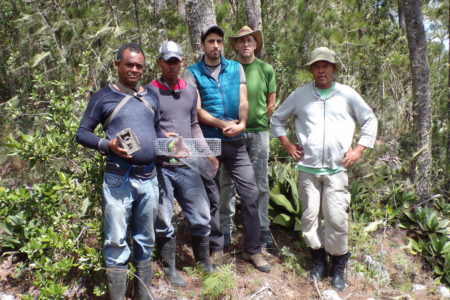
The Mysterious “Little Devil” – What We Know
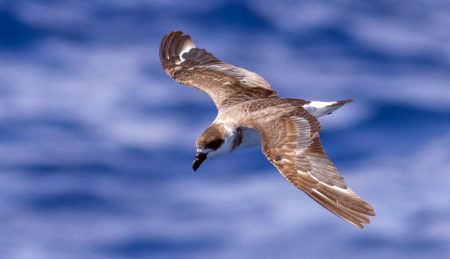
Black-capped Petrels (Pterodroma hasitata), like most gadfly petrels of the Pterodroma genus, are famously hard to study on land. As pelagic seabirds, they spend most of their lives at sea, only coming to land to nest from mid-January to mid-June. They were once more common in the Greater Antilles. They are locally known as Diablotin, the little devil. They are night birds and their eerie calls during the mating season give them their name. The bird’s breeding sites have been especially hard to find. They were only re-discovered in the 1960s in Haiti, and the 1980s in the Dominican Republic. As recently as last year, Ernst and his team found a new nesting area in the central mountain range of the Dominican Republic. There is hope that Black-capped Petrels might also be nesting in the Sierra Madre of Cuba (where they are known as brujas, the witches) and Dominica, but none have yet been found there.
Although better-studied than breeding sites, the marine habits of Black-capped Petrels also remain vague. Until recently, they were thought to fish the waters off the southeastern United States year-round. However, our 2014 satellite tracking study of three adults showed that they might in fact forage off the coasts of Colombia and Venezuela while raising chicks. During this expedition, we plan to track a dozen nesting petrels with lightweight GPS loggers and to study their diet. Once we know where they go and what they eat, we will better understand the secrets of their travels and the threats they face at sea.
“Como una aguja en un pajar” – The Proverbial Needle in a Haystack
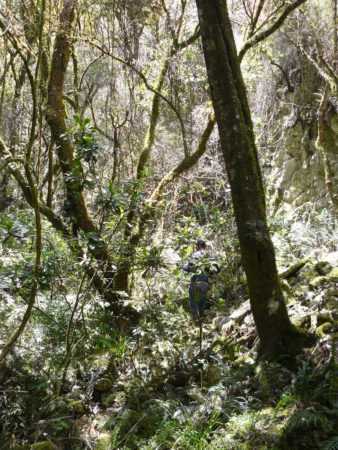
Before we can study the petrels though, we need to catch them. This is where the knowledge of Grupo Jaragua’s field technicians comes into play. The expression “a needle in a haystack” translates well in Spanish, and applies particularly well to their mission. In a haystack of dense mountainous vegetation, they are experts in finding the petrels’ burrows—underground “needles” hidden among rocky screes or under thick layers of leaf litter. Pirrín’s skill is in locating the nest entrances among the rocks and vegetation. He confirms his findings with the presence of a fly that seems to favor active nest sites: “Pirrín’s fly”. José Luis is in charge of the borescope. Maneuvering the thick cable of optical fibers as far as 2 meters underground, he inspects every corner of the burrow for signs of recent activity: a well-defined nest cup, an adult incubating the pair’s single egg, or a sleeping chick. Gerson, the team’s memory, can remember every burrow Grupo Jaragua has ever monitored. Knowing how to use rock-climbing equipment, he is also the group’s de facto safety officer, were the terrain to become too abrupt and exposed. Ivan is still a trainee; but if he learns as fast as he walks through the thick vegetation or climbs up and down the steep ravines, he will be finding new nesting sites very soon.
Small but Helpful Gems Found in a Burrow
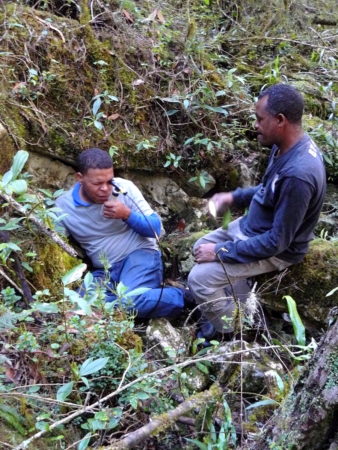
At each active burrow, I collect as many samples as I can. The first nest brings me beginner’s luck: just in front of the entrance a petrel dropping awaits. It is shiny and fresh from the previous night. My colleagues joke as I collect the dark part of the poop as if it were a golden nugget (the white part, urea, is useless for our testing). As insignificant as it looks, this little sample can tell us a lot. Thanks to my fellowship with the Dave Lee Fund, I will use DNA found in the sample and others like it to identify the species of prey eaten by Black-capped Petrels. Dave Lee himself had studied the petrel’s diet off the coast of North Carolina and showed that they favored squid. The technique available at the time, however, tended to put heavier focus on prey species that took a long time to digest (such as squid, whose beak fragments tend to build up in the digestive tract). With the molecular analysis of fecal DNA, I’m hoping to refine our knowledge of the diet of Black-capped petrels. This will help us better understand their life at sea.
José Luis hands me a few breast feathers left behind by adult petrels when they enter or exit the tunnel. Feathers can tell us about the broad diet of the bird through an analysis of stable isotopes. We can also use them to measure the bird’s exposure to mercury, which Black-capped Petrels are prone to bio-accumulate. Finally, if we are lucky, DNA left in the quill will inform us on the genetics of the local population. We are also interested in collecting remnants of eggs. If the egg has hatched, the remaining shell can be tested for contaminants. It can also provide clues to the diet of the female when she produced the egg. If the egg proved infertile, we will collect it with great care to bring it back to the Dominican National Museum of Natural History for their specimen collection.
More Finds for the Test Tube
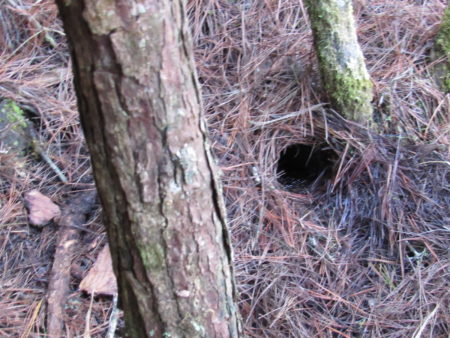
In an active burrow, I find an insect that seems to use the discarded feathers to make its cocoon, a black tube with protruding white barbs of the petrel’s feather. Could it be Pirrín’s fly? I plop the fly into a test tube; each sample joins our growing collection in a freezer, until we have enough funding to analyze them. Then Ivan comes back to me with good news. The team found a group of four nearby nests, with a chick in each burrow. To limit disturbance, we will be using GPS loggers that remotely send their tracking data to a base-station. Due to the dense vegetation and the steep surroundings, the range of the base-station is limited to a radius of about 300m. It is therefore crucial that we choose nest sites close to each other. Under Pirrín’s supervision, we set chicken-wire traps at the entrance of each tunnel to capture the adults as they return at night. After carefully concealing the traps’ openings under the rocks, sod, or pine needles surrounding the burrow, we take a deep breath and hike up to the nearest ridge. We are hoping for success when we come back at sunrise.
By Yvan Satge. Yvan is a Research Associate in the Lab of Dr. Pat Jodice, at the South Carolina Cooperative Fish & Wildlife Research Unit, Clemson University. He has been studying various aspects of seabird ecology for the last few years.
I am grateful for support for this project from the Neotropical Bird Club, BirdsCaribbean’s Dave S. Lee Fund, Grupo Jaragua, and the USGS – South Carolina Cooperative Fish & Wildlife Research Unit.
